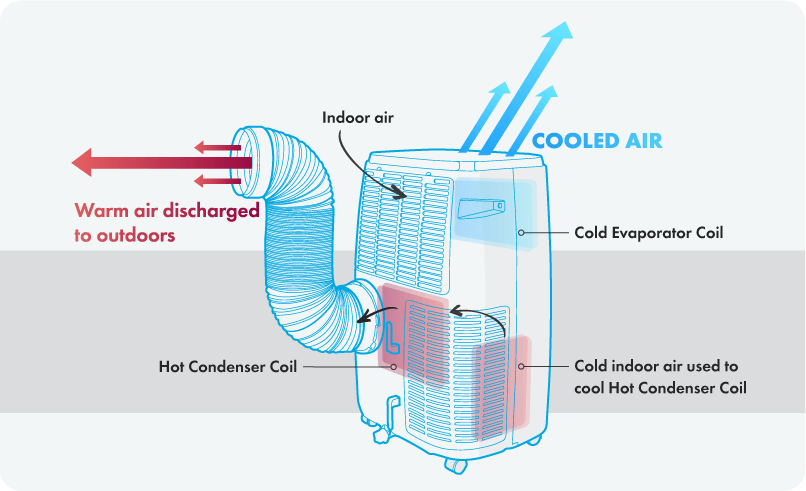Air conditioning units are a remarkable invention that allows us to stay cool and comfortable on hot days. But have you ever wondered how they work? In this article, we will break it down for you.
How It Works in Principle
Simply put, an air conditioning unit works like a fridge, but in reverse. Instead of keeping the cold air in, it blows it out into the room. Warm air from the room is drawn inside the unit and cleaned through the filter. It then passes over the cold evaporator coil, which cools down the air. This chilled air is then circulated back into the room bringing down the temperature. The removed heat and moisture are vented outside through the ducting hose.
What’s Inside an Air Conditioning Unit?
Air conditioning units are made up of a few key components.

These parts work together in a continuous cycle, removing heat from air inside, and releasing it outside. Cool air is then blown back into the room. This brings the room temperature down, leaving you feeling cool and comfortable.
Let us take a closer look at each part:
- Thermostat
The thermostat is the part you control and set. It senses the temperature and signals the air conditioning system to turn on or off as needed to maintain the desired temperature. Some units have a remote control or even Wi-Fi connectivity, which makes adjusting the desired temperature easy.
- Filter
Warm air from the room is drawn in through the filter. The filter removes dust, dirt, and other airborne particles from the air before it is cooled by the evaporator coil.
- Evaporator coil
This cools the air down.
- Blower
A high speed fan moves air over the evaporator and condenser coils to help transfer heat. Warm air from your room is passed over the evaporator coil (which is cold). This cools the air down and sent to the blower to be circulated back into the room.
- Compressor
The compressor is the heart of the system. It ‘compresses’ the refrigerant vapor inside the unit which creates heat and pressure. This increased heat and pressure enables the circulation of the refrigerant (the liquid that cools the air) from the evaporation coil to the condensing unit.
- Condensing unit
The device that removes the heat from the cooling process. The condensing unit on a wall split air conditioner is already located outside the property. A portable air conditioning unit needs a ducting kit to vent the heat outside.
- Expansion valve
The expansion valve regulates the flow of refrigerant into the evaporator coil.
- Ducting hose
The ducting hose carries hot air, generated during the cooling process, out of your room. Your room wouldn't cool down effectively without it.
Can Air Conditioners Be Used as a Dehumidifier?
Yes, an air conditioner can be used as a dehumidifier. Although not as powerful as a dedicated dehumidifier, a portable air conditioner (PAC) will remove moisture from the air, which is vented outside through the ducting hose. By reducing the humidity level in your home you'll create a more comfortable living environment and help prevent mould growth and other issues caused by excess moisture.
Can Air Conditioners Heat the Air?
Believe it or not, some air conditioning units can do both, cooling and heating. This means they can be used throughout the year, not just during the summer. They heat the room by reversing the flow of the refrigerant gas. Instead of absorbing heat from the indoor air, they release it, which heats up the room. Not all portable air conditioners have this, so make sure you look out for this feature if this is something you need.
Are you looking for more information about air conditioners? Check out our:








 Desk Fans
Desk Fans
 Pedestal Fans
Pedestal Fans
 Floor Fans
Floor Fans
 Tower Fans
Tower Fans
 DC Fans
DC Fans
 Air Circulators
Air Circulators
 Portable Air Conditioners
Portable Air Conditioners
 Evaporative Air Coolers
Evaporative Air Coolers
 Wall Mounted Air Conditioning Units
Wall Mounted Air Conditioning Units
 Commercial Cooling
Commercial Cooling
 Ceiling Cassette Air Conditioning
Ceiling Cassette Air Conditioning
 Home Dehumidifiers
Home Dehumidifiers
 Drying Clothes Dehumidifiers
Drying Clothes Dehumidifiers
 Low Energy Dehumidifiers
Low Energy Dehumidifiers
 Compressor Dehumidifiers
Compressor Dehumidifiers
 Desiccant Dehumidifiers
Desiccant Dehumidifiers
 Commercial Dehumidifiers
Commercial Dehumidifiers
 Wall Mounted Dehumidifiers
Wall Mounted Dehumidifiers
 Dehumidifier Accessories
Dehumidifier Accessories
 Humidifiers & Air Purifiers
Humidifiers & Air Purifiers
 Inline Fans
Inline Fans
 Kitchen Extractor Fans
Kitchen Extractor Fans
 Bathroom Extractor Fans
Bathroom Extractor Fans
 Commercial Extractor Fans
Commercial Extractor Fans
 Shower Extractor Fans
Shower Extractor Fans
 Silent Extractor Fans
Silent Extractor Fans
 Heat Recovery Extractor Fans
Heat Recovery Extractor Fans
 PIV & Whole House Ventilation
PIV & Whole House Ventilation
 Extractor Fan Accessories
Extractor Fan Accessories
 Extractor Fan Controllers
Extractor Fan Controllers
 Panel Heaters
Panel Heaters
 Fan Heaters
Fan Heaters
 Patio Heaters
Patio Heaters
 Storage Heaters
Storage Heaters
 Towel Rails
Towel Rails
 Underfloor Heating
Underfloor Heating



 Electric Fires
Electric Fires
 Time Controllers
Time Controllers
 Ducting Kits
Ducting Kits
 Internal Grilles
Internal Grilles
 External Grilles
External Grilles
 Ducting Hose
Ducting Hose
 Ducting Clamps
Ducting Clamps
 Ducting Connectors
Ducting Connectors

 Electric Radiators
Electric Radiators
 Oil Filled Radiators
Oil Filled Radiators
 Oil Free Radiators
Oil Free Radiators
 Designer Radiators
Designer Radiators
 Water Boilers
Water Boilers
 Under Sink Water Heaters
Under Sink Water Heaters
 Over Sink Water Heaters
Over Sink Water Heaters
 Unvented Water Heaters
Unvented Water Heaters
 Instant Water Heaters
Instant Water Heaters
 Boiling Water Taps
Boiling Water Taps
 Hand Wash Units
Hand Wash Units
 Air Curtains
Air Curtains
 Returned Air Conditioners
Returned Air Conditioners
 Returned Fans
Returned Fans
 Returned Dehumidifiers
Returned Dehumidifiers
 Returned Heaters
Returned Heaters




